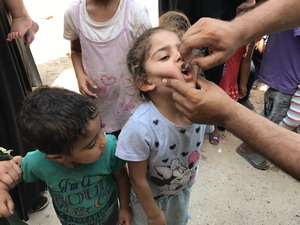The first cases of the cVDPV2 outbreak were confirmed in June 2017, in Deir Ez-Zor governorate in eastern Syria. It resulted in 74 cases, the most recent of which had onset of paralysis more than 12 months ago, on 21 September 2017.
“Ending a polio outbreak is a complex task, involving disease detection, intensive outbreak response, liaising between different parties and stakeholders, prompt delivery of oral polio vaccine to large populations that are frequently on the move, and detailed and ongoing surveillance for acute flaccid paralysis,” said Anirban Chatterjee, Regional Chief of Health for UNICEF Middle East and North Africa. “The cessation of this outbreak is a win for public health and a major achievement for all partners who supported efforts to contain and control the outbreak.”
“Surveillance is stronger today than it was 18 months ago, when the initial cases were detected,” said Chris Maher, Manager for Polio Eradication in the WHO Eastern Mediterranean Region. “Access for both surveillance and immunization is dramatically better, and immunity levels have been increased as a result of the comprehensive outbreak response conducted across Syria.”
However, risks around the re-emergence of cVDPV or the reintroduction of wild poliovirus remain high for Syria. “So, as we celebrate what is a remarkable achievement in stopping this outbreak, amid very challenging circumstances, we must not lose sight of the risks posed by continued circulation of virus in other parts of our Region. Efforts must continue to build on boosting immunity levels and strengthening our disease surveillance,” Mr Maher said.
This outbreak was tackled with the same outbreak response approach that successfully stopped a wild poliovirus type 1 (WPV1) outbreak in 2013 in the same area of Syria. Despite the high risks associated with large-scale population movements, deteriorated health infrastructure, and the access and insecurity issues affecting some of the outbreak area, effective collaboration by local authorities on surveillance and vaccination ensured health workers could reach and vaccinate enough children to raise immunity levels. Donor engagement, including support by Gavi, the Vaccine Alliance and the Global Polio Eradication Initiative, helped ensure maximum coverage for the campaign, regardless of the children’s location and areas of control.
Syria is no longer infected with polio but is vulnerable to re-infection. It remains subject to temporary recommendations issued by the International Health Regulations Emergency Committee.
Lessons learnt from this outbreak response regarding excellent coordination, timely implementation of response activities, vaccine management, grassroots community engagement and strengthened surveillance systems are being applied to other areas with similar challenges, including in the Horn of Africa, currently affected by strains of both cVDPV2 and cVDPV3.
For more information please contact:
Emma Sykes
WHO Polio Communications Officer
+962 7 91329071
Dr Fazal Ather
Regional Polio and Outbreaks Coordinator
UNICEF Middle East and North Africa
+962 7 98100579









